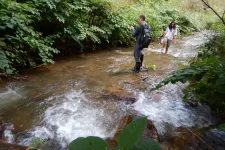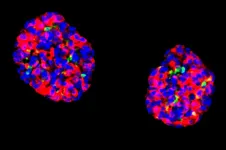(Press-News.org) If we could rewind the tape of species evolution around the world and play it forward over hundreds of millions of years to the present day, we would see biodiversity clustering around regions of tectonic turmoil. Tectonically active regions such as the Himalayan and Andean mountains are especially rich in flora and fauna due to their shifting landscapes, which act to divide and diversify species over time.
But biodiversity can also flourish in some geologically quieter regions, where tectonics hasn’t shaken up the land for millennia. The Appalachian Mountains are a prime example: The range has not seen much tectonic activity in hundreds of millions of years, and yet the region is a notable hotspot of freshwater biodiversity.
Now, an MIT study identifies a geological process that may shape the diversity of species in tectonically inactive regions. In a paper appearing in Science, the researchers report that river erosion can be a driver of biodiversity in these older, quieter environments.
They make their case in the southern Appalachians, and specifically the Tennessee River Basin, a region known for its huge diversity of freshwater fishes. The team found that as rivers eroded through different rock types in the region, the changing landscape pushed a species of fish known as the greenfin darter into different tributaries of the river network. Over time, these separated populations developed into their own distinct lineages.
The team speculates that erosion likely drove the greenfin darter to diversify. Although the separated populations appear outwardly similar, with the greenfin darter’s characteristic green-tinged fins, they differ substantially in their genetic makeup. For now, the separated populations are classified as one single species.
“Give this process of erosion more time, and I think these separate lineages will become different species,” says Maya Stokes PhD ’21, who carried out part of the work as a graduate student in MIT’s Department of Earth, Atmospheric and Planetary Sciences (EAPS).
The greenfin darter may not be the only species to diversify as a consequence of river erosion. The researchers suspect that erosion may have driven many other species to diversify throughout the basin, and possibly other tectonically inactive regions around the world.
“If we can understand the geologic factors that contribute to biodiversity, we can do a better job of conserving it,” says Taylor Perron, the Cecil and Ida Green Professor of Earth, Atmospheric, and Planetary Sciences at MIT.
The study’s co-authors include collaborators at Yale University, Colorado State University, the University of Tennessee, the University of Massachusetts at Amherst, and the Tennessee Valley Authority (TVA). Stokes is currently an assistant professor at Florida State University.
Fish in trees
The new study grew out of Stokes’ PhD work at MIT, where she and Perron were exploring connections between geomorphology (the study of how landscapes evolve) and biology. They came across work at Yale by Thomas Near, who studies lineages of North American freshwater fishes. Near uses DNA sequence data collected from freshwater fishes across various regions of North America to show how and when certain species evolved and diverged in relation to each other.
Near brought a curious observation to the team: a habitat distribution map of the greenfin darter showing that the fish was found in the Tennessee River Basin — but only in the southern half. What’s more, Near had mitochondrial DNA sequence data showing that the fish’s populations appeared to be different in their genetic makeup depending on the tributary in which they were found.
To investigate the reasons for this pattern, Stokes gathered greenfin darter tissue samples from Near’s extensive collection at Yale, as well as from the field with help from TVA colleagues. She then analyzed DNA sequences from across the entire genome, and compared the genes of each individual fish to every other fish in the dataset. The team then created a phylogenetic tree of the greenfin darter, based on the genetic similarity between fish.
From this tree, they observed that fish within a tributary were more related to each other than to fish in other tributaries. What’s more, fish within neighboring tributaries were more similar to each other than fish from more distant tributaries.
“Our question was, could there have been a geological mechanism that, over time, took this single species, and splintered it into different, genetically distinct groups?” Perron says.
A changing landscape
Stokes and Perron started to observe a “tight correlation” between greenfin darter habitats and the type of rock where they are found. In particular, much of the southern half of the Tennessee River Basin, where the species abounds, is made of metamorphic rock, whereas the northern half consists of sedimentary rock, where the fish are not found.
They also observed that the rivers running through metamorphic rock are steeper and more narrow, which generally creates more turbulence, a characteristic greenfin darters seem to prefer. The team wondered: Could the distribution of greenfin darter habitat have been shaped by a changing landscape of rock type, as rivers eroded into the land over time?
To check this idea, the researchers developed a model to simulate how a landscape evolves as rivers erode through various rock types. They fed the model information about the rock types in the Tennessee River Basin today, then ran the simulation back to see how the same region may have looked millions of years ago, when more metamorphic rock was exposed.
They then ran the model forward and observed how the exposure of metamorphic rock shrank over time. They took special note of where and when connections between tributaries crossed into non-metamorphic rock, blocking fish from passing between those tributaries. They drew up a simple timeline of these blocking events and compared this to the phylogenetic tree of diverging greenfin darters. The two were remarkably similar: The fish seemed to form separate lineages in the same order as when their respective tributaries became separated from the others.
“It means it’s plausible that erosion through different rock layers caused isolation between different populations of the greenfin darter and caused lineages to diversify,” Stokes says.
This research was supported, in part, by the Terra Catalyst Fund and the U.S. National Science Foundation through the AGeS Geochronology Program and the Graduate Research Fellowship Program. While at MIT, Stokes received support through the Martin Fellowship for Sustainability and the Hugh Hampton Young Fellowship.
###
Written by Jennifer Chu, MIT News Office
END
River erosion can shape fish evolution, study suggests
The new findings could explain biodiversity hotspots in tectonically quiet regions
2023-05-25
ELSE PRESS RELEASES FROM THIS DATE:
River erosion drives fish biodiversity in the Appalachians
2023-05-25
New Haven, Conn. — The gradual erosion of layers of rock by rivers flowing through the Appalachian Mountains generates biodiversity of freshwater fish species, suggests a new Yale-led study that offers insight into the causes of species richness in the ancient mountain range.
Researchers have previously associated high biodiversity in mountain ranges, including the Andes and Himalaya, with tectonic uplift — the shifting of plates in the Earth’s crust that forms mountains, plateaus, and other geologic structures — triggering environmental changes that create conditions ripe for species diversification. ...
Researchers at the Faculty of Physics of the University of Warsaw have created a new, highly efficient converter of quantum information carriers
2023-05-25
Researchers at the University of Warsaw's Faculty of Physics have developed a new, highly efficient technique that makes quantum information transmission dozens of times faster. The results of the research, published in the prestigious journal Nature Photonics, may in the near future contribute to the development of superfast quantum Internet connections.
Light is a key carrier of information. It enables high-speed data transmission around the world via fiber-optic telecommunication networks. This information-carrying capability can be extended to transmitting quantum information by encoding ...
Making the structure of 'fire ice' with nanoparticles
2023-05-25
Images // Video
Cage structures made with nanoparticles could be a route toward making organized nanostructures with mixed materials, and researchers at the University of Michigan have shown how to achieve this through computer simulations.
The finding could open new avenues for photonic materials that manipulate light in ways that natural crystals can't. It also showcased an unusual effect that the team is calling entropy compartmentalization.
"We are developing new ways to structure ...
Large study provides scientists with deeper insight into long COVID symptoms
2023-05-25
Large study provides scientists with deeper insight into long COVID symptoms
NIH-funded research effort identifies most common symptoms, potential subgroups, and initial symptom-based scoring system – with aim of improving future diagnostics and treatment
Initial findings from a study of nearly 10,000 Americans, many of whom had COVID-19, have uncovered new details about long COVID, the post-infection set of conditions that can affect nearly every tissue and organ in the body. Clinical symptoms can vary and include fatigue, brain fog, and dizziness, and last for months or years after ...
Intravenous plus periarticular corticosteroids improve rehabilitation measures after knee replacement
2023-05-25
May 25, 2023 – For patients undergoing total knee arthroplasty (TKA), a combination of intravenous and periarticular corticosteroids does not improve pain control – but, may improve key indicators of functional recovery in the days after surgery, reports a trial in The Journal of Bone & Joint Surgery. The journal is published in the Lippincott portfolio in partnership with Wolters Kluwer.
Intravenous (IV) plus periarticular (PA) steroids "yielded more significant improvements in the rehabilitation parameters," ...
Microneedling plus cupping may aid skin rejuvenation
2023-05-25
May 25, 2023 – A combination of emerging and alternative techniques – microneedling to induce collagen and cupping to increase tissue perfusion – may have a synergistic effect in producing skin rejuvenation, according to an experimental study in the June issue of Plastic and Reconstructive Surgery®, the official medical journal of the American Society of Plastic Surgeons (ASPS). The journal is published in the Lippincott portfolio by Wolters Kluwer.
"Cupping therapy can be added to microneedling therapy and used to increase certain desired effects on skin," comments lead author Burak Pasinlioğlu, MD, of Kecioren Research ...
Scientists target human stomach cells for diabetes therapy
2023-05-25
Stem cells from the human stomach can be converted into cells that secrete insulin in response to rising blood sugar levels, offering a promising approach to treating diabetes, according to a preclinical study from researchers at Weill Cornell Medicine.
In the study, which appeared April 27 in Nature Cell Biology, the researchers showed that they could take stem cells obtained from human stomach tissue and reprogram them directly—with strikingly high efficiency—into cells that closely resemble pancreatic insulin-secreting cells known as beta cells. Transplants of small groups of these cells reversed disease signs in a mouse model of diabetes.
“This ...
Sage’s 10-Year Impact Awards recognize research with long-term influence
2023-05-25
For the fourth year, Sage has awarded 10-Year Impact Awards to three research articles that have had a lasting influence over the past decade. The awards are given to the authors of three papers published in Sage Journals in 2012 that have received the most citations in the 10 years since than all other studies published in the same year.
The three winning papers are:
“The Nature and Organization of Individual Differences in Executive Functions: Four General Conclusions” by Akira Miyake and Naomi P. Friedman in Current Directions ...
CU researchers weave deeper understanding of diverse ancestry and gene expression
2023-05-25
Exploring diverse ancestry is a critical factor in furthering medical research.
A new study published in Nature Genetics from researchers in the Department of Biomedical Informatics (DBMI) at the University of Colorado School of Medicine, in partnership with the University of California San Francisco and Stanford University, is the largest of its kind that focuses on ancestry correlations with biomedical traits and the first study to examine the role of genetic variants across diverse ...
Does body contouring increase long-term weight loss after bariatric surgery? New findings
2023-05-25
May 25, 2023 – For patients with massive weight loss after bariatric surgery, subsequent body contouring to remove excess skin is not itself associated with long-term weight loss, reports a study in the June issue of Plastic and Reconstructive Surgery®, the official medical journal of the American Society of Plastic Surgeons (ASPS). The journal is published in the Lippincott portfolio by Wolters Kluwer.
"In contrast to previous studies, we found that body contouring ...
LAST 30 PRESS RELEASES:
Collaborative study uncovers unknown causes of blindness
Inflammatory immune cells predict survival, relapse in multiple myeloma
New test shows which antibiotics actually work
Most Alzheimer’s cases linked to variants in a single gene
Finding the genome's blind spot
The secret room a giant virus creates inside its host amoeba
World’s vast plant knowledge not being fully exploited to tackle biodiversity and climate challenges, warn researchers
New study explains the link between long-term diabetes and vascular damage
Ocean temperatures reached another record high in 2025
Dynamically reconfigurable topological routing in nonlinear photonic systems
Crystallographic engineering enables fast low‑temperature ion transport of TiNb2O7 for cold‑region lithium‑ion batteries
Ultrafast sulfur redox dynamics enabled by a PPy@N‑TiO2 Z‑scheme heterojunction photoelectrode for photo‑assisted lithium–sulfur batteries
Optimized biochar use could cut China’s cropland nitrous oxide emissions by up to half
Neural progesterone receptors link ovulation and sexual receptivity in medaka
A new Japanese study investigates how tariff policies influence long-run economic growth
Mental trauma succeeds 1 in 7 dog related injuries, claims data suggest
Breastfeeding may lower mums’ later life depression/anxiety risks for up to 10 years after pregnancy
Study finds more than a quarter of adults worldwide could benefit from GLP-1 medications for weight loss
Hobbies don’t just improve personal lives, they can boost workplace creativity too
Study shows federal safety metric inappropriately penalizes hospitals for lifesaving stroke procedures
Improving sleep isn’t enough: researchers highlight daytime function as key to assessing insomnia treatments
Rice Brain Institute awards first seed grants to jump-start collaborative brain health research
Personalizing cancer treatments significantly improve outcome success
UW researchers analyzed which anthologized writers and books get checked out the most from Seattle Public Library
Study finds food waste compost less effective than potting mix alone
UCLA receives $7.3 million for wide-ranging cannabis research
Why this little-known birth control option deserves more attention
Johns Hopkins-led team creates first map of nerve circuitry in bone, identifies key signals for bone repair
UC Irvine astronomers spot largest known stream of super-heated gas in the universe
Research shows how immune system reacts to pig kidney transplants in living patients
[Press-News.org] River erosion can shape fish evolution, study suggestsThe new findings could explain biodiversity hotspots in tectonically quiet regions


